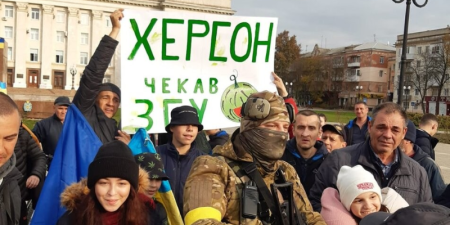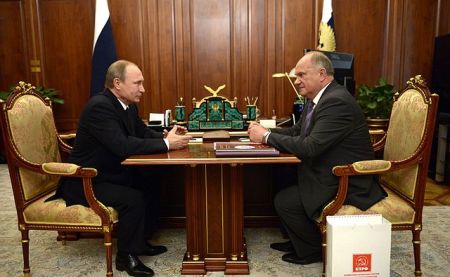 |
| 18-November-2022 |
The four main parties in the Russian parliament have supported the “destruction of Ukrainian statehood in every form – cultural, political, ideological and historical”, concludes a report by the Eastern Human Rights Group (EHRG), a Ukrainian organisation set up in Donetsk in 2015 by trade union and civil rights activists.
 |
| People in Kherson welcoming Ukrainian troops. Photo from the World Ukrainian Congress site |
The report finds that the Communist Party of the Russian Federation (CPRF) and A Just Russia, another nominally left-wing party, have helped to lead Russia’s campaign of control over the eastern Donetsk and Luhansk regions over the past eight years. It also addresses the role of the ruling party, United Russia, and the Liberal Democratic Party of Russia (LDPR), an extreme right-wing populist party.
The CPRF and A Just Russia were active in the self-proclaimed “people’s republics” of Donetsk and Luhansk from 2015, despite Russia’s acceptance of the Minsk peace agreements that acknowledged those areas as Ukrainian.
The two “left” parties gave voice to aggressive policies, such as recognition and other formal support for the illegal “republics”, and to ideologies associated with the “Russian world” – a concept of cross-border Russian culture that supports Russian imperial claims – more stridently than government figures.
After this year’s all-out invasion of Ukraine, Russia’s pro-government opposition parties have supported the administrative and political structures hastily imposed in newly occupied areas of Ukraine.
The parties’ collaboration with Russia’s military activity in Ukraine went through four phases, the report shows: (i) from the 2014 invasion to 2021; (ii) from 2021, when the Kremlin began preparations to recognise the Donetsk and Luhansk “republics”, to 2022; (iii) between the February invasion and the Kremlin’s announcement of the annexation of Ukrainian regions in September; and (iv) after the pseudo-referendums and annexation.
1. From 2014 to 2021
As the Russian government negotiated and signed the Minsk peace agreements in 2014 and 2015, it distanced itself publicly from direct involvement with the “people’s republics” in Donetsk and Luhansk. (More on the Minsk agreements in note at the end.)
The lead was taken by A Just Russia, which from its foundation in 2006 has acted as the ultimate loyal opposition to the Putin government. Its leader, Sergei Mironov, was chair of the Russian Senate from 2001 to 2011.
In November 2014, says the EHRG, Mironov met with the Luhansk and Donetsk leaders, calling for the republics’ “statehood” to be strengthened and claiming that Ukraine had been “destroyed” as a state.
 |
| Gennady Zyuganov, leader of the Russian Communist party (right), with Vladimir Putin in 2015 |
While the Kremlin blamed Ukraine for the breakdown of the Minsk process, in 2017 Mironov proposed legislation to make Russian passports easily available to Donbas citizens. In 2020, he called for the “republics” to be granted special status within the Russian Federation. He also hosted leaders from Luhansk and Donetsk on visits to Moscow.
The CPRF, meanwhile, focused on active support for the pro-Russian militia. The party says that it has delivered more than 100 convoys of aid. This, according to the EHRG report, included ammunition, weapons for international volunteers fighting on the Russian side, and supplies for military hospitals, as well as propaganda.
CPRF delegations formed “active relationships” with leaders of separatist militia, including Alexey Mozgovoi of the “Prizrak” militia group, and Alexander Bednov of the “Batman” group (both killed in 2015, most likely due to internal disputes in Luhansk). Bednov had previously run a torture centre, according to the Kyiv Post.
The CPRF was also in contact with Pavel Dremov, who formed a Cossack regiment to fight against Ukrainian forces in the Donbas, having previously seen service with pro-Russian militia in Transnistria and Chechnya. He was assassinated in 2015.
The Russian Communist party also had contact with Mikhail Tolstykh, a commander who served under the extreme right-wing Russian militant Igor Strelkov, and specialised in humiliating Ukrainian prisoners on video. He was killed in a rocket attack against his headquarters in 2017.
The EHRG found that the LDPR, while less active on the ground, consistently supported the Russian occupation of territory. Vladimir Zhirinovsky, its leader until his death earlier this year, urged the Kremlin to take “more radical action” against Ukraine.
2. From May 2021 to February 2022
In 2019, the Russian government, in breach of the Minsk agreements, started a campaign to issue passports to Donbas residents. By May 2021 more than 500,000 Russian passports had been distributed in Donetsk and Luhansk regions, official figures suggest. Moscow ruled that these citizens should be entitled to vote in the Russian parliamentary election of September 2021.
From the start of the election campaign, the EHRG states, “all political activity” in the “republics” was reserved to the Kremlin’s own party, United Russia.
“Other Russian parties’ activity was forbidden or halted,” and United Russia had an effective monopoly on the Donbas political space until April 2022.
Luhansk and Donetsk branches of the Communist Party, which had local origins, were less severely affected. But “Sergei Mironov’s party was even forbidden to organise visits. Things only loosened up in the summer of 2022,” the report states.
Just before this year’s invasion, Russian politicians – led by the Communist Party – called on the Kremlin to recognise the Donetsk and Luhansk republics on the grounds that there were 860,000 Russian citizens there.
Meanwhile senior United Russia figures oversaw the distribution of party cards to deputies of the People’s Assemblies of Donetsk and Luhansk, which had previously been supposedly “non-party”, and to local government employees.
3. From February to September 2022
The United Russia party machine moved rapidly into Ukrainian towns and cities newly occupied by the Russian forces this year. Sergei Kirienko, deputy head of the Russian presidential administration, toured workplaces together with Andrei Turchak, deputy chair of the Russian Senate, and Denis Pushilin, leader of the Donetsk “republic”, urging workers to join United Russia.
They organised ceremonies to present party cards to newly-appointed pro-Russian officials in Kherson, Melitopol and Zaporizhzhya region. Turchak claimed that 142,000 members of the Donetsk Republic civic movement had applied to join United Russia.
 |
| Authors Vera Yastrebova and Pavel Lisyansky of the Eastern Human Rights Group at the report’s launch yesterday. Photo from EHRG |
United Russia officials helped to introduce the Russian Federation’s curricula and exam standards into Ukrainian schools in the occupied territories, the EHRG reports. This went alongside pro-Russian local authorities’ efforts to drive out Ukrainian language and history teaching, and to deport thousands of Ukrainian children to Russia.
After the full-scale invasion, as tens of thousands of Russians risked arrest to demonstrate against the war, the tame opposition parties awaited the Kremlin’s signal that they should return to the occupied territories. The CPRF expelled its deputies in the Primorsk regional parliament who spoke out against the war.
And in the run-up to the referendums on accession to the Russian federation, held in September in Kherson, Zaporizhzhya, Donetsk and Luhansk, the de facto ban on the CPRF and A Just Russia was lifted.
Mironov of A Just Russia toured the region, meeting with the head of the Luhansk “republic” Leonid Pasechnik, and the president of its tame trade union federation, Igor Riabushkin. In Moscow, CPRF leader Gennady Zyuganov met the Luhansk and Donetsk leaders and assured them of his party’s support for the referendums.
4. After the September referendums
The EHRG report suggests that attempts are being made to reproduce in Ukraine the traditional “division of labour” between United Russia and the loyal opposition parties in Russia. United Russia recruits people in administrative and management jobs, in a manner reminiscent of the Soviet Communist Party in the 1970s and 1980s; Russia’s loyal opposition offers a sounding-board for dissent over everyday hardships, poor living standards and corrupt local officials.
The United Russia organisations in eastern Ukraine are now headed by senior figures in the occupied areas’ administrations: Denis Pushilin, effective head of the Donetsk administration; Denis Miroshnichenko, chair of the People’s Assembly in Luhansk; and Galina Dalnichenko, one of the prominent political figures in Zaporizhzhya to collaborate with the Russian military. The party organisation in Kherson was headed by an “import”: Igor Kastiukevich, a member of the Russian parliament.
While the CPRF and A Just Russia organisations are based on previously-existing political forces, all four leaders of the LDPR organisations are “imports”.
Readers in the UK might remember the man who is now head of the LDPR in Kherson: Russian parliamentarian Andrei Lugovoi, who after service in the FSB (federal security service) in the 1990s became a private security consultant – and who was later held responsible, by the European Court of Human Rights and a UK government investigation, for the death of Aleksander Litvinenko, the former FSB agent who defected.
The situation in Kherson has been “further complicated” by the Ukrainian counter-offensive, the EHRG notes, as Russian politicians and media personnel do not want to take up posts in the region.
At home in Russia, the loyal opposition parties have in recent months vied with United Russia politicians to step up their anti-Ukrainian rhetoric.
For example in September, a few days before the Kremlin announced the “partial mobilisation” into the Russian army, CPRF parliamentary deputy Sergei Obukhov urged that the “special military operation” be stepped up, and supported a call by Ramzan Kadyrov, the warmongering ruler of Chechnya, for Russian regions to find more soldiers.
♞ This article first appeared in Open Democracy.
♞ The EHRG report, Activities of Russian Parties on the Temporarily Occupied Territories of Ukraine, was released yesterday, together with a second report on The Conduct of the Pseudo-Referendums in the Temporarily Occupied Territories of Ukraine. It is available in Russian only. Requests for copies should be addressed to East.hr.group@gmail.com.
Note. The Minsk agreements
There are two Minsk documents. The second, signed in February 2015, is the most important. That agreement between Russia and Ukraine was intended to stop the fighting in the Donbas region of Ukraine, and was signed when Ukraine was experiencing some of its heaviest losses against Russian-controlled forces in winter 2015.
While the first section of the Minsk Agreements established a ceasefire, prisoner exchange and military withdrawal from the line of contact, the second dealt with the Ukrainian government restoring control over its eastern border and holding local elections in the occupied territories, followed by the reintegration of Donbas into Ukraine via a special autonomy status.
There is a good description of the Minsk agreements by Isobel Koshiw here, and a view of why they didn’t work, by Taras Bilous, here.






No comments